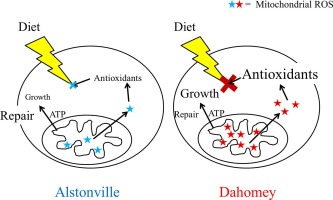当前位置:
X-MOL 学术
›
J. Insect Physiol.
›
论文详情
Our official English website, www.x-mol.net, welcomes your feedback! (Note: you will need to create a separate account there.)
Yin and Yang of mitochondrial ROS in Drosophila.
Journal of Insect Physiology ( IF 2.2 ) Pub Date : 2020-02-08 , DOI: 10.1016/j.jinsphys.2020.104022 Samuel G Towarnicki 1 , Leanne M Kok 2 , J William O Ballard 1
Journal of Insect Physiology ( IF 2.2 ) Pub Date : 2020-02-08 , DOI: 10.1016/j.jinsphys.2020.104022 Samuel G Towarnicki 1 , Leanne M Kok 2 , J William O Ballard 1
Affiliation

|
In this study, we test the hypothesis that Drosophila larvae producing mildly elevated levels of endogenous mitochondrial reactive oxygen species (ROS) benefit in stressful environmental conditions due to the priming of antioxidant responses. Reactive oxygen species (ROS) are produced as a by-product of oxidative phosphorylation and may be elevated when mutations decrease the efficiency of ATP production. In moderation, ROS are necessary for cell signaling and organismal health, but in excess can damage DNA, proteins, and lipids. We utilize two Drosophila melanogaster strains (Dahomey and Alstonville) that share the same nuclear genetic background but differ in their mitochondrial DNA haplotypes. Previously, we reported that Dahomey larvae harboring the V161L ND4 mtDNA mutation have reduced proton pumping and higher levels of mitochondrial ROS than Alstonville larvae when they are fed a 1:2 protein: carbohydrate (P:C) diet. Here, we explore the potential for mitochondrial ROS to provide resistance to dietary stressors by feeding larvae 1:2 P:C food supplemented with ethanol or hydrogen peroxide (H2O2). When fed a diet supplemented with ethanol or H2O2, Dahomey develop more quickly than Alstonville into larger pupae, while Alstonville developed faster on the control. Dahomey larvae displayed higher antioxidant capacity than Alstonville on all diets, with mitochondrial H2O2 levels unchanged after the addition of stressors. Addition of stressors to the diet did not affect the mitochondrial functions of Dahomey larvae as measured by mitochondrial membrane potential, respiratory control ratio, or larval survival after bacterial challenge. In contrast, Alstonville larvae developed slower, had lower pupal weight, higher cytosolic H2O2, and had reduced mitochondrial functions. Further, Alstonville larvae fed the ethanol treated diet had lower survival after bacterial infection than those fed the control diet. Surprisingly, they had greater survival when fed diet with H2O2 indicating a mitotype by stressor interaction that influences the immune response. Overall, these data suggest that elevated mitochondrial ROS in Dahomey can result in greater antioxidant capacity that prevents oxidative damage from exogenous stressors and may be a conserved response to high ethanol found in rotting fruit.
中文翻译:

果蝇中线粒体ROS的阴和阳。
在这项研究中,我们测试了以下假设:果蝇幼虫产生内源性线粒体活性氧(ROS)的水平略有升高,这是由于抗氧化剂反应的启动在压力环境条件下有益的。活性氧(ROS)是氧化磷酸化的副产物,当突变降低ATP的产生效率时,活性氧可能会升高。适度地,ROS对于细胞信号和机体健康是必需的,但是过量会破坏DNA,蛋白质和脂质。我们利用两个果蝇果蝇菌株(达荷美和阿尔斯顿维尔),它们共享相同的核遗传背景,但线粒体DNA单倍型不同。先前,我们报道,当喂食蛋白质为1:2的碳水化合物:碳水化合物(P:C)饲料时,与Alstonville幼虫相比,带有V161L ND4 mtDNA突变的Dahomey幼虫具有降低的质子泵送和较高的线粒体ROS水平。在这里,我们探索线粒体ROS通过喂食添加了乙醇或过氧化氢(H2O2)的1:2 P:C幼虫食物来抵抗饮食压力的潜力。当饲喂补充有乙醇或H2O2的日粮时,达荷美犬比阿尔斯顿维尔更快地成长为较大的p,而阿尔斯顿维尔在对照中的发展更快。在所有日粮中,Dahomey幼虫的抗氧化能力均高于Alstonville,添加应激源后线粒体H2O2含量保持不变。饮食中添加应激源不会影响Dahomey幼虫的线粒体功能(通过线粒体膜电位,呼吸控制率或细菌激发后幼虫存活来衡量)。相反,Alstonville幼虫发育较慢,p重量较低,胞质H2O2较高,线粒体功能降低。此外,饲喂乙醇处理的日粮的阿尔斯顿维尔幼虫在细菌感染后的存活率低于对照日粮。出人意料的是,当喂食过氧化氢饮食时,它们具有更大的存活率,这表明通过应激物相互作用影响免疫反应的线型。总体,
更新日期:2020-03-20
中文翻译:

果蝇中线粒体ROS的阴和阳。
在这项研究中,我们测试了以下假设:果蝇幼虫产生内源性线粒体活性氧(ROS)的水平略有升高,这是由于抗氧化剂反应的启动在压力环境条件下有益的。活性氧(ROS)是氧化磷酸化的副产物,当突变降低ATP的产生效率时,活性氧可能会升高。适度地,ROS对于细胞信号和机体健康是必需的,但是过量会破坏DNA,蛋白质和脂质。我们利用两个果蝇果蝇菌株(达荷美和阿尔斯顿维尔),它们共享相同的核遗传背景,但线粒体DNA单倍型不同。先前,我们报道,当喂食蛋白质为1:2的碳水化合物:碳水化合物(P:C)饲料时,与Alstonville幼虫相比,带有V161L ND4 mtDNA突变的Dahomey幼虫具有降低的质子泵送和较高的线粒体ROS水平。在这里,我们探索线粒体ROS通过喂食添加了乙醇或过氧化氢(H2O2)的1:2 P:C幼虫食物来抵抗饮食压力的潜力。当饲喂补充有乙醇或H2O2的日粮时,达荷美犬比阿尔斯顿维尔更快地成长为较大的p,而阿尔斯顿维尔在对照中的发展更快。在所有日粮中,Dahomey幼虫的抗氧化能力均高于Alstonville,添加应激源后线粒体H2O2含量保持不变。饮食中添加应激源不会影响Dahomey幼虫的线粒体功能(通过线粒体膜电位,呼吸控制率或细菌激发后幼虫存活来衡量)。相反,Alstonville幼虫发育较慢,p重量较低,胞质H2O2较高,线粒体功能降低。此外,饲喂乙醇处理的日粮的阿尔斯顿维尔幼虫在细菌感染后的存活率低于对照日粮。出人意料的是,当喂食过氧化氢饮食时,它们具有更大的存活率,这表明通过应激物相互作用影响免疫反应的线型。总体,



























 京公网安备 11010802027423号
京公网安备 11010802027423号